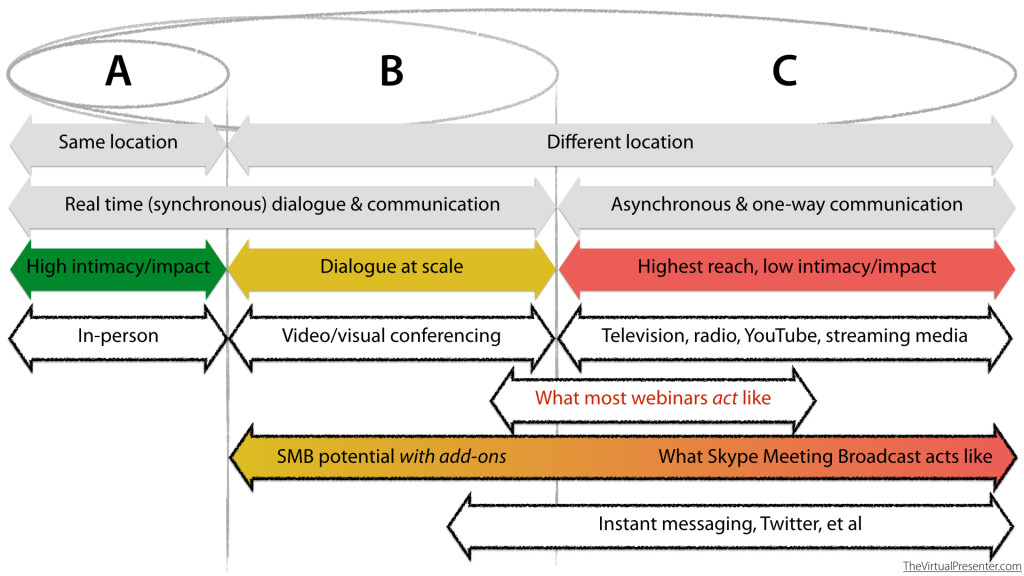Will #Skype Meeting Broadcast be the next webinar killer?
Earlier this year Microsoft announced Skype for Business (SFB hereafter), it’s replacement of Lync. They’ve subsequently announced Skype Meeting Broadcast (SfMB hereafter) as a component of SFB that will scale a meeting to 10,000 participants. Word on the street is that they’ll announce something next month (Sept ’15), too, but Microsoft hasn’t posted anything about it that I can find.
Here’s why I don’t think this is a threat to the webinar business (yet).
Microsoft has solved a Microsoft problem, not THE problem
Microsoft’s problem is that Lync-now-SFB only scales to 250 people and, presumably, their clients are asking for more. Broadcasting it live to 10,000 people is their next step.
So what’s THE problem?
The challenge is that the world is now participative and collaborative. People expect to have a voice, to participate. This remains the grand potential of webinars, webcasts, and virtual classrooms (more on that in a moment).
Remember, optimization drives valuation, and sooner or later the distinct advantages and disadvantages of a media form settle into where they belong.
In the chart below, “A” represents communication and dialogue that happens in the same time and place – something we’ve known for all of human history.
“C” is the domain of broadcast. Despite many broadcasts being “live,” there is no dialogue between the speaker and listener (think television). This isn’t wrong, and it has its place.

“B” is a more recent development in historical terms. Dialogue at scale. Beyond the dialogue that can happen between audience and presenter (everyone sits in the front row when virtual!), there’s potential to facilitate peer-to-peer dialogue (oh, like an in-person conference? Yup.).
It’ll be slightly philosophical, but here me on this: just using the web to replace other broadcast media doesn’t solve the “where the world is going” problem. Competitive analyses have long necessarily included “alternative use of capital,” and anyone needing to reach thousands have always had the ability to send a pre-published video, rent a satellite truck for a private broadcast, etc., for reaching a pile of people.
But that’s not what we do on the web. Sooner or later people with participative, collaborative expectations don’t want to be talked AT, they want to be talked WITH. And if you don’t be the leader of the conversation, they’ll go do it on their own – hey, just like they talk in the hallways and aisles at an in-person conference.
In other words, if engagement is desired, lecture or broadcast fits only a small use case. Again, not wrong, but not what most of us are looking for.
What to consider
Stay focused on your use case
The primary use case for meetings of that size is internal meetings. It costs a lot of money to put 1000s of butts in seats, and there are much more cost effective asynchronous media for sharing information at scale. That’s the subject of another post, but suffice it to say that events of that magnitude are rare in the scheme of things.
Find software that delivers what you need
Webinar/webcast hosts have long contended with needing a different solution than the corporately-purchased-by-IT-for-everyone meeting-oriented solutions. It’s why Citrix and WebEx and Adobe et al have interactive, event-oriented solutions. Of note, it’s also why scrappy-industry-veteran small organizations like Rally make tools to fill SfMB’s gaps.
Demand more from your presenters and presentations
We’ll never put an end to lousy presentations, but there’s a reason why the conferencing industry continues to see pressure in webinar/webcast attendance rates. There’s less compelling reason to be there for the live, shared experience when the live event is no different than watching a YouTube video. And the engagement problem isn’t theoretical for presenters and facilitators. They need to be taught what to do differently.
Learn to listen, interact, and facilitate guided conversation at scale
A change of medium means there’s a change in how you engage people. It doesn’t mean it can’t be done. It’s why you regularly find GoToWebinar hosts religiously facilitating engagement with Twitter hashtags or Adobe Connect producers opening up an everybody-sees-it chat pod. It’s why Rally adds-on that interactive functionality to SfMB (and takes advantage of other unified communications integration). If you’re going to ask an audience for a calendar appointment (a higher psychosocial cost to them), make it participative.
The bottom line: gravity wins
Sooner or later, the shifting tide will bring things into line (heck, I started in the industry when you had to build registration pages for webinars by hand. Not kidding…there were no solutions that had ‘em built in).
Sooner or later the level of producer and presenter competency will rise to meet the demands of people who don’t want to come to just another passive experience. You’re seeing the change in in-person conferences from lecture to more participative experiences, and webinars/webcasts will catch up.
Sooner or later Microsoft will get its solution right. More often than not, whether they build it or buy it, Microsoft peeps aren’t stupid, and they’ve got the staying power to give themselves time to figure it out.
Skype Meeting Broadcast won’t be putting webinar/webcast competitors out of business anytime soon. But only a fool would fail to keep an eye on it.
